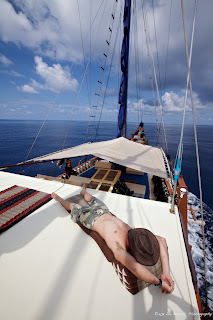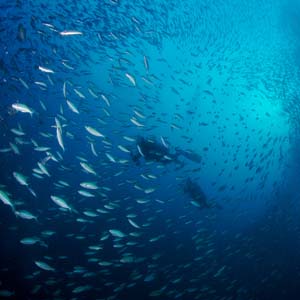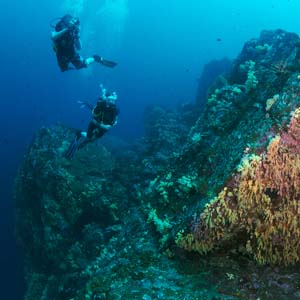Wicked Diving operates in places with a great deal of sunshine. That’s partly why so many people join us again and again. Our
Similan Dive Center is located just 10 degrees north of the Equator in Thailand and out Komodo Dive Center is located 8 degrees South of the equator. A major concern for all our guests and staff should be sun-exposure.
Why is it important to use sunscreen?
Skin damage from sunlight builds up with continued exposure, whether sunburn occurs or not. In addition to skin cancer and sunburn, other effects can include wrinkling, premature aging, and in time, an almost leathery appearance of the skin. Research also suggests that excessive exposure to UV radiation may interfere with the body’s immune system.
Sunburn is associated with the shorter ultraviolet wavelengths, known as ultraviolet B (UVB). The longer wavelengths, known as ultraviolet A (UVA), however, can penetrate the skin and damage connective tissue at deeper levels, even if the skin’s surface feels cool. It is important to limit exposure to both UVA and UVB.
Sunscreens play an important role in a total program to reduce the harmful effects of the sun, along with limiting sun exposure and wearing protective clothing.
To help consumers select products that best suit their needs, sunscreens are labeled with SPF numbers. SPF stands for “Sun Protection Factor.” The higher the SPF number, the more sunburn protection the product provides. Remember, sunscreen use alone will not prevent all of the possible harmful effects of the sun.
Is My Sunscreen Harming Corals?
Coral is a living organism that needs algae for food. Research now shows that certain ingredients in regular suntan lotions activate viruses inside algae. When these viruses replicate, they kill off the algae. Without the algae, the coral dies.
Four main ingredients that harm coral cited in a recent study are: paraben, cinnamate, benzophenone, and camphor. Avoid these ingredients. Some experts also recommend avoiding suntan lotion with anything beginning with “oxy” or “hexa.” Another problem with some sunscreens is that the oil in them can float in the water, blocking sunlight. So try to avoid sunscreen that seems to come off too easily and leave oily residue.
Look for ingredients that say biodegradable, organic or natural or that assert that they are coral safe, reef safe, eco safe or environmentally friendly. Remember, these terms do not guarantee that the product is ocean-safe. You still need to check the actual ingredient list. Look for active ingredients that are thought to be safer, such as zinc oxide, titanium dioxide, and avobenzone. The good news is that these ingredients are probably not only safer for the environment, but also safer for you.
Increasingly department stores and Pharmacies are offering environmentally safe sunscreen. You can also look in health food stores. For the best selection, look online, the internet has lots of choices and you can read customer reviews before buying.
Ocean-safe sunscreen or sunblock is effective. If it says it offers SPF 30, for example, it will protect you as well as a regular SPF 30.
It is worth noting that biodegradable sunscreen may blend in differently upon application. Some brands work better when rubbed in more slowly as they may congeal when applied too quickly. You may need to experiment to find the best ocean-safe sunscreen for you. Reading reviews on the internet may help you choose.
Apply ocean-friendly sunscreen or sunblock early. If you apply 10 to 20 minutes before you enter the water, the lotion has a chance to absorb into the skin, and less of it will wash off. Rub in slowly but as much as you can. Sunscreen will rub in better than sunblock, which is more opaque. Even environmentally friendly products can contain ingredients that float in the water, blocking sunlight. Coral need sunlight to thrive. So apply early, apply sparingly, and rub in thoroughly.
Wear a rash vest to protect your upper body and shoulders. Only apply ocean-safe sunscreen to areas that will be in the sun whilst snorkeling or swimming, such as your face and back of the legs.
Other personal products, such as antiperspirant, perfume, and body lotion, may also harm the delicate reef eco-system, so do not wear these when swimming in the ocean, especially when near coral.
Even the oil and bacteria in your skin can harm coral, so do your best to never touch coral. Keep fins away as well. If you can’t maintain positive buoyancy without touching the coral, then move away to another area or wear a life vest if you are snorkelling.
Stay safe – take care of your skin. Think locally and take care of the reefs we visit in Thailand and Komodo
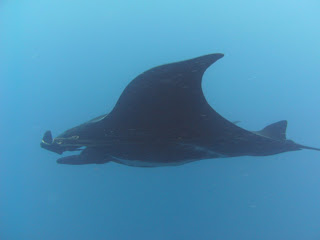 But on the second go we decided to stay at
the west ridge for the whole dive because the good current was a promising
event! And it was worth it!!!
But on the second go we decided to stay at
the west ridge for the whole dive because the good current was a promising
event! And it was worth it!!! 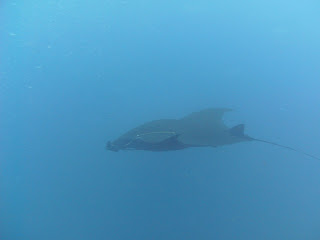
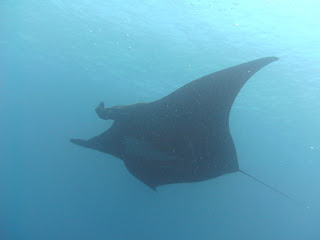 We were the only group again on that side
of the ridge as it was not the easiest spot to hang around and at the end it
paid off: three Manta Rays showed up together just as we were about to head off
for our safety stop. Such a pity none of us could get a picture of them
together but we were just starting to ascent from our safe spot next to the
ridge and the current really started to swirl around at that point, so we bid
farewell to this beautiful creatures and safely head to the surface.
We were the only group again on that side
of the ridge as it was not the easiest spot to hang around and at the end it
paid off: three Manta Rays showed up together just as we were about to head off
for our safety stop. Such a pity none of us could get a picture of them
together but we were just starting to ascent from our safe spot next to the
ridge and the current really started to swirl around at that point, so we bid
farewell to this beautiful creatures and safely head to the surface.
